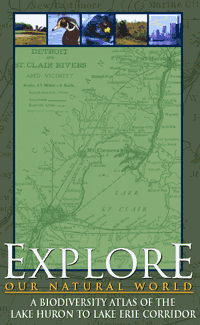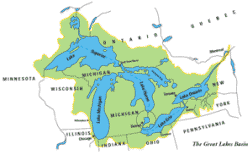St. Clair Biodiversity
Explore Our Natural World: A Biodiversity Atlas of the Lake Huron to Lake Erie Corridor

- Table of contents
- Preface
- Introduction
- Physical landscape (PDF)
- On the open water (PDF)
- Along the shoreline (PDF)
- Heading inland (PDF)
- Human Influence (PDF)
- You can help (PDF)
- Afterword
- Appendix
- Glossary
- Index
- Entire document (PDF) (pp, 7.2 MB)
Credits:
This book is dedicated to all of the plants and animals that live in this region and the people who have yet to learn about them.
Project Designer, Manager and Researcher – Lisa M. Appel
Contributing Writers – Lisa M. Appel, Julie A. Craves, Mary Kehoe
Smith,
Bob Weir and John M. Zawiskie
Editors – Mary Kehoe Smith and Bob Weir
Graphic Design – Peter Schade/Schade Design, Inc.
www.schadedesign.com
Funding for this project was provided by the U.S Environmental Protection Agency Great Lakes National Program Office to the Wildlife Habitat Council.
Thank you to the following contributors who supported the publication of this book.


This Biodiversity Atlas tells the story of the natural communities found in the Lake Huron to Lake Erie Corridor.
The Corridor is made up of the St. Clair River, Lake St. Clair and Detroit River, as well as the watersheds of southwestern Ontario and southeastern Michigan that drain into these great waterways. Water in the Corridor flows from the mouth of Lake Huron through the St. Clair River, Lake St. Clair and the Detroit River, into Lake Erie. The tributary rivers, creeks, streams and drains in the watersheds connect the surrounding lands to the Corridor.
This Atlas is organized according to elevations above sea level - from lower to higher - from the open waters and tributaries to the shoreline and lakeplain, and finally to the ecosystems of the interior lands that drain into the Corridor.
A wide variety of life forms - biodiversity - make the Corridor unique. The glacial history, climate, soils and water resources have created a landscape that is home to an incredible diversity of natural communities: forests, savannas, grasslands and wetlands. Within these natural communities live species that have global ecological significance.
A goal of everyone involved in producing this Atlas is that readers will gain a better understanding of this amazing region, and a desire to play an active role in caring for it.
![[logo] US EPA](../gif/logo_epaseal.gif)